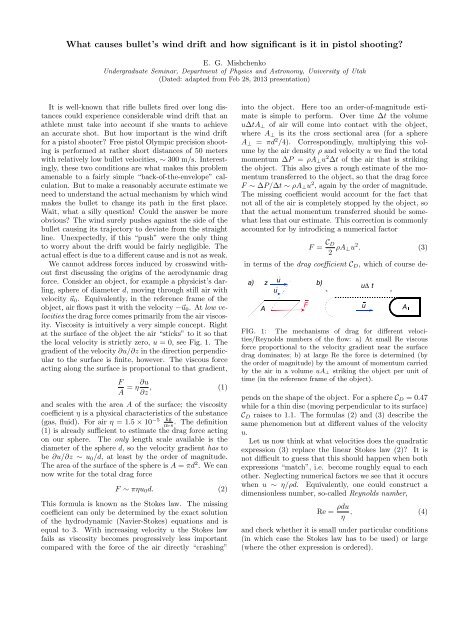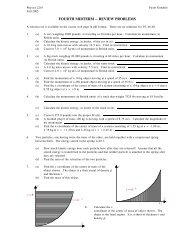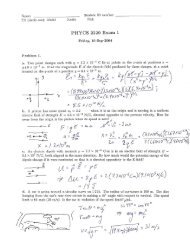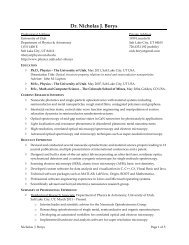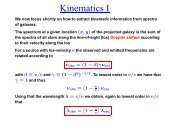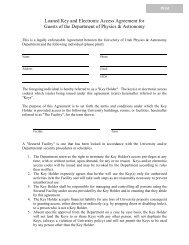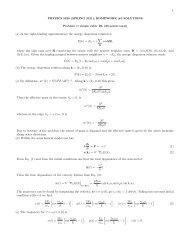Undergraduate seminar: bullet's drift in a crosswind - Department of ...
Undergraduate seminar: bullet's drift in a crosswind - Department of ...
Undergraduate seminar: bullet's drift in a crosswind - Department of ...
Create successful ePaper yourself
Turn your PDF publications into a flip-book with our unique Google optimized e-Paper software.
What causes bullet’s w<strong>in</strong>d <strong>drift</strong> and how significant is it <strong>in</strong> pistol shoot<strong>in</strong>g?<br />
E. G. Mishchenko<br />
<strong>Undergraduate</strong> Sem<strong>in</strong>ar, <strong>Department</strong> <strong>of</strong> Physics and Astronomy, University <strong>of</strong> Utah<br />
(Dated: adapted from Feb 28, 2013 presentation)<br />
It is well-known that rifle bullets fired over long distances<br />
could experience considerable w<strong>in</strong>d <strong>drift</strong> that an<br />
athlete must take <strong>in</strong>to account if she wants to achieve<br />
an accurate shot. But how important is the w<strong>in</strong>d <strong>drift</strong><br />
for a pistol shooter? Free pistol Olympic precision shoot<strong>in</strong>g<br />
is performed at rather short distances <strong>of</strong> 50 meters<br />
with relatively low bullet velocities, ∼ 300 m/s. Interest<strong>in</strong>gly,<br />
these two conditions are what makes this problem<br />
amenable to a fairly simple “back-<strong>of</strong>-the-envelope” calculation.<br />
But to make a reasonably accurate estimate we<br />
need to understand the actual mechanism by which w<strong>in</strong>d<br />
makes the bullet to change its path <strong>in</strong> the first place.<br />
Wait, what a silly question! Could the answer be more<br />
obvious? The w<strong>in</strong>d surely pushes aga<strong>in</strong>st the side <strong>of</strong> the<br />
bullet caus<strong>in</strong>g its trajectory to deviate from the straight<br />
l<strong>in</strong>e. Unexpectedly, if this “push” were the only th<strong>in</strong>g<br />
to worry about the <strong>drift</strong> would be fairly negligible. The<br />
actual effect is due to a different cause and is not as weak.<br />
We cannot address forces <strong>in</strong>duced by crossw<strong>in</strong>d without<br />
first discuss<strong>in</strong>g the orig<strong>in</strong>s <strong>of</strong> the aerodynamic drag<br />
force. Consider an object, for example a physicist’s darl<strong>in</strong>g,<br />
sphere <strong>of</strong> diameter d, mov<strong>in</strong>g through still air with<br />
velocity ⃗u 0 . Equivalently, <strong>in</strong> the reference frame <strong>of</strong> the<br />
object, air flows past it with the velocity −⃗u 0 . At low velocities<br />
the drag force comes primarily from the air viscosity.<br />
Viscosity is <strong>in</strong>tuitively a very simple concept. Right<br />
at the surface <strong>of</strong> the object the air “sticks” to it so that<br />
the local velocity is strictly zero, u = 0, see Fig. 1. The<br />
gradient <strong>of</strong> the velocity ∂u/∂z <strong>in</strong> the direction perpendicular<br />
to the surface is f<strong>in</strong>ite, however. The viscous force<br />
act<strong>in</strong>g along the surface is proportional to that gradient,<br />
F<br />
A = η ∂u<br />
∂z , (1)<br />
and scales with the area A <strong>of</strong> the surface; the viscosity<br />
coefficient η is a physical characteristics <strong>of</strong> the substance<br />
(gas, fluid). For air η = 1.5 × 10 −5 kg<br />
m·s<br />
. The def<strong>in</strong>ition<br />
(1) is already sufficient to estimate the drag force act<strong>in</strong>g<br />
on our sphere. The only length scale available is the<br />
diameter <strong>of</strong> the sphere d, so the velocity gradient has to<br />
be ∂u/∂z ∼ u 0 /d, at least by the order <strong>of</strong> magnitude.<br />
The area <strong>of</strong> the surface <strong>of</strong> the sphere is A = πd 2 . We can<br />
now write for the total drag force<br />
F ∼ πηu 0 d. (2)<br />
This formula is known as the Stokes law. The miss<strong>in</strong>g<br />
coefficient can only be determ<strong>in</strong>ed by the exact solution<br />
<strong>of</strong> the hydrodynamic (Navier-Stokes) equations and is<br />
equal to 3. With <strong>in</strong>creas<strong>in</strong>g velocity u the Stokes law<br />
fails as viscosity becomes progressively less important<br />
compared with the force <strong>of</strong> the air directly “crash<strong>in</strong>g”<br />
<strong>in</strong>to the object. Here too an order-<strong>of</strong>-magnitude estimate<br />
is simple to perform. Over time ∆t the volume<br />
u∆tA ⊥ <strong>of</strong> air will come <strong>in</strong>to contact with the object,<br />
where A ⊥ is its the cross sectional area (for a sphere<br />
A ⊥ = πd 2 /4). Correspond<strong>in</strong>gly, multiply<strong>in</strong>g this volume<br />
by the air density ρ and velocity u we f<strong>in</strong>d the total<br />
momentum ∆P = ρA ⊥ u 2 ∆t <strong>of</strong> the air that is strik<strong>in</strong>g<br />
the object. This also gives a rough estimate <strong>of</strong> the momentum<br />
transferred to the object, so that the drag force<br />
F ∼ ∆P/∆t ∼ ρA ⊥ u 2 , aga<strong>in</strong> by the order <strong>of</strong> magnitude.<br />
The miss<strong>in</strong>g coefficient would account for the fact that<br />
not all <strong>of</strong> the air is completely stopped by the object, so<br />
that the actual momentum transferred should be somewhat<br />
less that our estimate. This correction is commonly<br />
accounted for by <strong>in</strong>trodic<strong>in</strong>g a numerical factor<br />
F = C D<br />
2 ρA ⊥u 2 . (3)<br />
a)<br />
A<br />
z<br />
<strong>in</strong> terms <strong>of</strong> the drag coefficient C D , which <strong>of</strong> course deu<br />
u<br />
F<br />
b)<br />
u∆ t<br />
FIG. 1: The mechanisms <strong>of</strong> drag for different velocities/Reynolds<br />
numbers <strong>of</strong> the flow: a) At small Re viscous<br />
force proportional to the velocity gradient near the surface<br />
drag dom<strong>in</strong>ates; b) at large Re the force is determ<strong>in</strong>ed (by<br />
the order <strong>of</strong> magnitude) by the amount <strong>of</strong> momentum carried<br />
by the air <strong>in</strong> a volume uA ⊥ strik<strong>in</strong>g the object per unit <strong>of</strong><br />
time (<strong>in</strong> the reference frame <strong>of</strong> the object).<br />
pends on the shape <strong>of</strong> the object. For a sphere C D = 0.47<br />
while for a th<strong>in</strong> disc (mov<strong>in</strong>g perpendicular to its surface)<br />
C D raises to 1.1. The formulas (2) and (3) describe the<br />
same phenomenon but at different values <strong>of</strong> the velocity<br />
u.<br />
Let us now th<strong>in</strong>k at what velocities does the quadratic<br />
expression (3) replace the l<strong>in</strong>ear Stokes law (2)? It is<br />
not difficult to guess that this should happen when both<br />
expressions “match”, i.e. become roughly equal to each<br />
other. Neglect<strong>in</strong>g numerical factors we see that it occurs<br />
when u ∼ η/ρd. Equivalently, one could construct a<br />
dimensionless number, so-called Reynolds number,<br />
u<br />
Re = ρdu<br />
η , (4)<br />
and check whether it is small under particular conditions<br />
(<strong>in</strong> which case the Stokes law has to be used) or large<br />
(where the other expression is ordered).<br />
A
2<br />
u − u 0 w<strong>in</strong>d<br />
φ<br />
u<br />
0<br />
u<br />
w<strong>in</strong>d<br />
− u<br />
w<strong>in</strong>d<br />
φ<br />
F<br />
FIG. 2: Drag coefficient C D = 2F/ρA ⊥ u 2 as a function <strong>of</strong> the<br />
Reynolds number Re = ρdu/η <strong>in</strong> as the log-log plot. (This is<br />
a classic graph <strong>of</strong> the fluid mechanics, this particular image<br />
taken from: http://www.ecourses.ou.edu).<br />
Let me po<strong>in</strong>t out that the situations where two limits<br />
“cross over” <strong>in</strong>to each other are ubiquitous <strong>in</strong> physics.<br />
In a vast majority <strong>of</strong> them where two expression should<br />
match they do so <strong>in</strong> a region where their ratio is ∼ 1.<br />
Interest<strong>in</strong>gly, the aerodynamic drag is one notable exception,<br />
as the “switch<strong>in</strong>g” from (2) to (3) occurs at Re<br />
<strong>of</strong> the order <strong>of</strong> several hundred. Fig. 2 illustrates how this<br />
crossover happens for the case <strong>of</strong> a sphere as the Reynolds<br />
number is <strong>in</strong>creased (which itself can be viewed is a dimensionless<br />
measure <strong>of</strong> velocity, <strong>in</strong> units <strong>of</strong> η/ρd). At<br />
not very large Re < 100 the Stokes law is the right approximation;<br />
between Re ∼ 10 2 − 10 3 it crosses over to<br />
the quadratic behavior (3) which rema<strong>in</strong>s valid for over<br />
two orders <strong>of</strong> magnitude before a sudden reduction <strong>of</strong> the<br />
drag occurs (the “drag crisis”). The latter is a very <strong>in</strong>terest<strong>in</strong>g<br />
phenomenon but well beyond the scope <strong>of</strong> our<br />
discussion.<br />
Let us see where small-bore pistol bullet parameters<br />
land us on this graph. Diameter <strong>of</strong> the bullet d ∼ 0.5<br />
cm, velocity v ≈ 300 m/s, and air density ρ = 1.2 kg/m 3<br />
yield Re ∼ 1.5 × 10 5 . This number is well with<strong>in</strong> the<br />
plateau region <strong>of</strong> the graph on Fig. 2, where the drag<br />
force is described by the formula (3) that from now on is<br />
go<strong>in</strong>g to be used.<br />
We are now equipped with enough understand<strong>in</strong>g to<br />
perform the estimate <strong>of</strong> the w<strong>in</strong>d <strong>drift</strong> effect. We assume<br />
the most unfavorable situation <strong>of</strong> a w<strong>in</strong>d blow<strong>in</strong>g exactly<br />
90 degrees to the bullet’s path with the velocity u w<strong>in</strong>d .<br />
Repeat<strong>in</strong>g the momentum transfer arguments <strong>of</strong> the preced<strong>in</strong>g<br />
paragraphs one would expect that the w<strong>in</strong>d push<br />
on the side <strong>of</strong> the bullet is given by F w<strong>in</strong>d ∼ ρAu 2 w<strong>in</strong>d ,<br />
which is second order <strong>in</strong> the w<strong>in</strong>d velocity. However, such<br />
naïve reason<strong>in</strong>g would greatly underestimate the <strong>drift</strong> effect.<br />
An attentive reader can guess that someth<strong>in</strong>g is<br />
amiss after realiz<strong>in</strong>g that the amount <strong>of</strong> air the bullet<br />
comes <strong>in</strong>to contact with is <strong>in</strong> fact determ<strong>in</strong>ed by the velocity<br />
<strong>of</strong> the bullet u 0 that under any practical conditions<br />
is much greater than u w<strong>in</strong>d .<br />
FIG. 3: F<strong>in</strong>d<strong>in</strong>g the drag force act<strong>in</strong>g on the bullet: w<strong>in</strong>d<br />
velocity is shown via black arrow. Tilted blue arrow <strong>in</strong>dicates<br />
the direction <strong>of</strong> the bullet’s velocity ⃗u 0 −⃗u w<strong>in</strong>d <strong>in</strong> the reference<br />
frame <strong>of</strong> the w<strong>in</strong>d, it is given by the vector difference <strong>of</strong> the<br />
bullet’s velocity ⃗u 0 with respect to the ground and the velocity<br />
<strong>of</strong> the w<strong>in</strong>d.<br />
The easiest way to proceed is illustrated with Fig. 3.<br />
In the reference frame <strong>of</strong> the w<strong>in</strong>d the bullet’s velocity is<br />
given by the vector ⃗u 0 −⃗u w<strong>in</strong>d , which makes a small angle<br />
ϕ ≈ tan ϕ = u w<strong>in</strong>d /u 0 with the bullet’s axis. The magnitude<br />
<strong>of</strong> the total drag force is changed very <strong>in</strong>significantly<br />
[1] from its “w<strong>in</strong>dless” value C D ρA ⊥ u 2 0/2, but its direction<br />
is tilted away from ⃗u 0 by the angle ϕ. The result<strong>in</strong>g<br />
lateral force is<br />
F x = C D<br />
2 ρA ⊥u 2 × u w<strong>in</strong>d<br />
= C D<br />
u 0 2 ρA ⊥u 0 u w<strong>in</strong>d . (5)<br />
It is now an exercise <strong>in</strong> k<strong>in</strong>ematics to f<strong>in</strong>d the bullet’s<br />
horizontal displacement that occurs over the duration<br />
<strong>of</strong> its flight to the target. The lateral acceleration is<br />
a x = F x /m, which after time t (start<strong>in</strong>g with zero lateral<br />
velocity) leads to the horizontal shift ∆x = a x t 2 /2.<br />
The time <strong>of</strong> flight is roughly the ratio <strong>of</strong> the distance to<br />
the target L to the bullet’s muzzle velocity, t = L/u 0 , if<br />
the bullet’s deceleration is disregarded (see below). By<br />
putt<strong>in</strong>g now everyth<strong>in</strong>g together we arrive at the estimate,<br />
∆x = C ρA ⊥ L 2<br />
4 m<br />
u w<strong>in</strong>d<br />
u 0<br />
. (6)<br />
Note, foremost, that the <strong>drift</strong> effect turned out to be<br />
<strong>of</strong> the first order <strong>in</strong> the w<strong>in</strong>d velocity. Qualitatively our<br />
f<strong>in</strong>d<strong>in</strong>g should be understood as follows. The lateral w<strong>in</strong>d<br />
<strong>drift</strong> is caused by the rotation <strong>of</strong> the total drag force over<br />
the angle proportional to the crossw<strong>in</strong>d speed. This rotation<br />
is k<strong>in</strong>ematic <strong>in</strong> orig<strong>in</strong>; <strong>in</strong> other words it is due to<br />
the vector character <strong>of</strong> velocities that add accord<strong>in</strong>g to<br />
Fig. 3.<br />
We can now apply formula (6) to the Olympic free pistol<br />
shoot<strong>in</strong>g which is done at distance <strong>of</strong> L = 50 m with<br />
the .22lr caliber ammunition (“small-bore”). The most<br />
popular bullets have weight <strong>of</strong> 40 gra<strong>in</strong> or 2.3×10 −3 kg <strong>in</strong><br />
the SI system <strong>of</strong> units. The typical bullet’s muzzle velocity<br />
is slightly subsonic, u 0 ≈ 300 m/s, and the bullet’s diameter<br />
(as explicitly <strong>in</strong>dicated <strong>in</strong> its caliber) is d = 0.224
3<br />
<strong>in</strong>ch = 0.56 cm, which gives A ⊥ = 2.7 × 10 −5 m 2 . We<br />
take the drag coefficient to be C = 0.3, a good approximation<br />
for a round-nosed elongated bullet. This signals<br />
better aerodynamics than the sphere’s (C D = 0.47) but<br />
not as good as Toyota Prius’ (C D = 0.25) [2]. F<strong>in</strong>ally<br />
we are free to pick up some w<strong>in</strong>d speed. In case <strong>of</strong> 20<br />
mph w<strong>in</strong>d (neither too weak not a hurricane), which <strong>in</strong><br />
SI units translates <strong>in</strong>to u w<strong>in</strong>d = 9 m/s, we obta<strong>in</strong><br />
∆x = 6 cm. (7)<br />
Is this displacement significant? Quite so. The diameter<br />
<strong>of</strong> the 10-r<strong>in</strong>g on a free pistol target is 5 cm while<br />
that <strong>of</strong> the 9-r<strong>in</strong>g is 10 cm, and so on, with the lower<br />
r<strong>in</strong>gs follow<strong>in</strong>g the pattern. We see that the 20 mph<br />
w<strong>in</strong>d can cost the shooter up to 3 po<strong>in</strong>ts, as 6 cm is<br />
deflection large enough to move the po<strong>in</strong>t <strong>of</strong> bullet’s impact<br />
from just the outside <strong>of</strong> the 10-r<strong>in</strong>g to the <strong>in</strong>side <strong>of</strong><br />
the 7-r<strong>in</strong>g! Of course the w<strong>in</strong>d’s effect on the shooter’s<br />
ability to hold steady and aim is probably go<strong>in</strong>g to be<br />
much more significant, as Olympic pistol shoot<strong>in</strong>g is performed<br />
one-handed <strong>in</strong> a rather precarious stance, unlike<br />
rifle shoot<strong>in</strong>g. On the other hand under such bad w<strong>in</strong>dy<br />
conditions the shooter would try to game the w<strong>in</strong>d by<br />
wait<strong>in</strong>g out for a periods <strong>of</strong> relative calm, but match tactics<br />
are beyond our objectives here. Return<strong>in</strong>g to the<br />
physics <strong>of</strong> bullet’s flight let us just appreciate the luck<br />
pistol shooters enjoy – the dependence on the distance<br />
to the target L is quadratic, which means that at longer<br />
ranges the w<strong>in</strong>d <strong>drift</strong> would become significantly more<br />
important very quickly.<br />
At the end discussion <strong>of</strong> some implicitly made approximations<br />
is <strong>in</strong> order. First, we should verify how well<br />
the assumption <strong>of</strong> the constancy <strong>of</strong> the bullet’s velocity<br />
holds over relevant distances L. How quickly is the aerodynamic<br />
drag decelerat<strong>in</strong>g the projectile? The relatively<br />
weak w<strong>in</strong>d <strong>drift</strong> (6) can be completely ignored now. The<br />
dynamics <strong>of</strong> the bullet <strong>in</strong> the direction towards the target<br />
is described by the 2nd Newton’s law, du/dt = −F/m.<br />
S<strong>in</strong>ce the drag force F given by equation (3) does not depend<br />
explicitly on time (only implicitly via u), a delightful<br />
“trick” is go<strong>in</strong>g to be very helpful (as it is <strong>in</strong> many<br />
other problems <strong>in</strong>volv<strong>in</strong>g differential equations). Change<br />
the variable from time t to the distance from the muzzle<br />
l, which amounts to transformation <strong>of</strong> the acceleration,<br />
du/dt = (du/dl)(dl/dt) = (du/dl)u. Us<strong>in</strong>g this expression<br />
<strong>in</strong> the left-hand side <strong>of</strong> the Newton’s law and substitut<strong>in</strong>g<br />
(3) <strong>in</strong>to its right-hand side we obta<strong>in</strong> a simple<br />
differential equation (note the cancelation <strong>of</strong> one power<br />
<strong>of</strong> u <strong>in</strong> both sides <strong>of</strong> the equation):<br />
du<br />
dl = −C DρA ⊥<br />
u, (8)<br />
2m<br />
whose solution is elementary,<br />
(<br />
u(l) = u 0 exp − C )<br />
DρA ⊥ l<br />
. (9)<br />
2m<br />
By us<strong>in</strong>g the same bullet parameters here as we did <strong>in</strong><br />
the rest <strong>of</strong> the above discussion we f<strong>in</strong>d that u(50m) ≈<br />
0.95u 0 , so that the relative decrease <strong>in</strong> the bullet’s velocity<br />
over the distance to the target is only 5%. This<br />
rather <strong>in</strong>significant correction does not affect much the<br />
accuracy <strong>of</strong> our estimates (6) and (7).<br />
As a conclud<strong>in</strong>g note, we have also neglected some<br />
other less strong but nevertheless <strong>in</strong>terest<strong>in</strong>g physical effects.<br />
One <strong>of</strong> those is the Coriolis force <strong>in</strong>duced by the<br />
Earth’s rotation. Its effect on projectile motion is considered<br />
<strong>in</strong> many theoretical mechanics textbooks. If <strong>in</strong>terested,<br />
you can follow the calculations and likely come<br />
to the conclusion that at distances <strong>of</strong> <strong>in</strong>terest to pistol<br />
shooters the Coriolis effect is not <strong>of</strong> much concern. The<br />
Magnus effect is more <strong>in</strong>trigu<strong>in</strong>g. The <strong>in</strong>terplay <strong>of</strong> crossw<strong>in</strong>d<br />
and bullet’s own sp<strong>in</strong> (<strong>in</strong>duced by grooves <strong>in</strong> the<br />
barrel <strong>of</strong> the gun) leads to the asymmetry <strong>of</strong> the air flow:<br />
for a bullet sp<strong>in</strong>n<strong>in</strong>g clock-wise the w<strong>in</strong>d blow<strong>in</strong>g from<br />
the left produces faster flow above the bullet and slower<br />
flow below it. At the most basic level <strong>in</strong> terms <strong>of</strong> the<br />
Bernoulli law, the slower/faster flow is characterized by<br />
higher/lower pressures. The bullet <strong>in</strong> our example will<br />
therefore be deflected upwards. (In the case <strong>of</strong> w<strong>in</strong>d from<br />
the right and the same direction <strong>of</strong> the bullet’s sp<strong>in</strong> the<br />
deflection would <strong>of</strong> course be downward.) Magnus effect<br />
should depend on the viscosity, even <strong>in</strong> case <strong>of</strong> high<br />
Reynolds numbers. Indeed, <strong>in</strong> the complete absence <strong>of</strong><br />
viscosity the air flow would not even “care” if the bullet<br />
is sp<strong>in</strong>n<strong>in</strong>g or not. We may try to estimate the Magnus<br />
effect at one <strong>of</strong> our next <strong>Undergraduate</strong> <strong>sem<strong>in</strong>ar</strong>s more<br />
quantitatively.<br />
[1] This change is due to the fact that the total velocity <strong>in</strong>creases<br />
to (u 2 0 + u 2 w<strong>in</strong>d) 1/2 . In addition the drag coefficient<br />
might have changed slightly for an oblique air flow. Both<br />
are m<strong>in</strong>uscule effects which <strong>in</strong> any case would exceed the<br />
accuracy <strong>of</strong> our calculations.<br />
[2] Curiously, the drag coefficient <strong>of</strong> a Formula 1 race car<br />
could easily reach 0.7-0.8 or be even higher. The reason is<br />
that such cars are set up not to achieve the least drag but<br />
to provide significant amount <strong>of</strong> downward force <strong>in</strong> order<br />
to <strong>in</strong>crease traction needed <strong>in</strong> tight turns.


